Probabilistic Deliverability Assessment of Distributed Energy Resources via Scenario-Based AC Optimal Power Flow
Abstract
1. Introduction
- The primary contributions of this paper are as follows:
- We assess current interconnection study practices and identify their limitations.
- We review approaches for modeling uncertainty in optimal power flow (OPF).
- We develop a modular scenario-based AC optimal power flow (AC OPF) framework that accommodates varying data granularity, integrates corrective dispatch, and produces probabilistic deliverability and reliability metrics.
- We demonstrate the framework on a minimal-data case study based on a publicly available 385-bus model of Puerto Rico’s bulk power system, evaluating hybrid solar–storage projects considering variable load, generation, and contingency conditions to inform bus-level DER siting aligned with decarbonization goals.
2. Assessment of Current DER Interconnection Study Practices
- Interconnection Studies Required Under the LGIP (>20 MW)
- Cluster Study (LGIP Section 7): Interconnection requests submitted during a defined Cluster Request Window are evaluated collectively via a cluster study. This study includes power flow, stability, and short-circuit analyses. A base case representation of system conditions at the time of the study is used (LGIP Section 2.3), including existing facilities and higher-queued projects. Potential impacts on system reliability are assessed and required Interconnection Facilities and network upgrades are identified, including non-binding, good faith estimates of cost and construction timelines.
- Interconnection Facility Study (LGIP Section 8): Performed after the cluster study (and any required restudies), this study informs the development of engineering designs, construction plans, and procurement requirements for the Interconnection Facilities and network upgrades. It provides refined cost estimates (typically within ±10–20% accuracy) and proposed timelines and reflects Interconnection Customer-specified assumptions related to equipment and operation.
- Affected System Study (LGIP Section 9): If a proposed project may impact another transmission provider’s system, an Affected System Study is required. This study evaluates reliability impacts using power flow, stability, and short-circuit analyses. It identifies any necessary Affected System Network Upgrades, provides a non-binding cost estimate, and determines cost allocation based on proportional impacts.
- Optional Interconnection Study (LGIP Section 10): Upon request, the Interconnection Customer may initiate an Optional Interconnection Study to evaluate alternate configurations or sensitivities beyond the standard scope. This can include changes in interconnection location, technology, or other variables of interest to the customer.
- Interconnection Studies Required Under the SGIP (≤ 20 MW)
- Feasibility Study (SGIP Section 3.3): This study identifies potential adverse system impacts resulting from the proposed project. Power flow, short-circuit capability, voltage regulation, protection coordination, and grounding requirement studies are performed. If no significant impacts are identified, the process may proceed directly to a Facility Study or an Interconnection Agreement. Otherwise, a System Impact Study is required.
- System Impact Study (SGIP Section 3.4): This study assesses the impacts of the proposed interconnection on system reliability, without project or network modifications. It may include power flow, short-circuit, stability, voltage drop, flicker, protection coordination, and grounding analyses, as appropriate. Separate evaluations may be conducted for transmission and distribution systems. Results inform the need for system modifications and provide preliminary estimates of costs and timelines.
- Facility Study (SGIP Section 3.5): This study informs the development of detailed engineering, procurement, and construction plans for any Interconnection Facilities or upgrades identified in the System Impact Study. It provides refined cost estimates and proposed timelines and outlines the configuration and switching equipment required to support a safe and reliable interconnection.
- Fast Track Process (SGIP Section 2): This is an expedited interconnection path for certified Small Generating Facilities that meet eligibility criteria based on capacity, location, and interconnection voltage. Projects are evaluated using predefined technical screens related to system configuration, fault current, voltage regulation, and protection. If all screens are passed, interconnection may proceed without further study.
- Supplemental Review (SGIP Section 2.4): This is applied to Fast Track-eligible projects that fail one or more initial screens. It involves three additional screens evaluating minimum load, voltage and power quality, and safety and reliability. If impacts are determined to be minimal and resolvable, the project may proceed with minor modifications or directly to an Interconnection Agreement.
2.1. Impact of Fixed Assumptions in Power Flow Solutions
- : Net active (real) power injection (+ for generation, − for load);
- : Net reactive power injection (+ for inductive, − for capacitive);
- : Voltage magnitude;
- : Voltage phase angle.
- Slack bus(es) where and are specified, and the system’s real and reactive power imbalances are absorbed;
- PV (generator) buses where and are specified, and and are solved for;
- PQ (load) buses where and are specified, and and are solved for.
2.2. Modeling Output Variability and Control Capabilities of DERs
2.3. Challenges in Modeling Dispatch Feasibility over Time
2.4. Preventive vs. Corrective Dispatch in Contingency Analysis
3. Approaches for Modeling Uncertainty in Optimal Power Flow
3.1. Chance-Constrained Optimal Power Flow
3.2. Stochastic Optimal Power Flow
- : [11] considers distribution-level planning, using a linearized OPF with 27 discrete scenarios capturing combined demand–wind–solar uncertainty on IEEE 69- and 94-bus feeders. At the transmission scale, [26] applies a data-driven scenario-enhancement scheme that reduces the number of representative samples required for tractable AC S-OPF, with demonstrations on IEEE 24-, 73-, and 118-bus systems and the 1354-bus PEGASE case. These formulations are computationally similar to CC-OPF approximations but enforce hard feasibility constraints.
- : [27] formulates a multi-period AC OPF for radial distribution networks with storage, where each timestep is an operating point scenario and solar forecast uncertainty is represented through a branching scenario tree. In our notation this corresponds to with , since each stage is represented by a single forecast value along each branch rather than by multiple independent samples. The method is demonstrated on a 56-bus system.
- : [28] develops a two-stage stochastic dispatch with reserves and uncertain carbon emissions, tested on the IEEE 118-bus system using scenarios generated via copula-based sampling. [29] formulates a 24 h stochastic AC OPF with wind forecast uncertainty, introducing a dynamic framework that couples inter-temporal constraints with sampled wind scenarios, tested on the IEEE 118-bus system.
3.3. Robust Optimal Power Flow
3.4. Scenario-Based Optimal Power Flow
4. Probabilistic Deliverability Assessment Framework
- Indexed Data Collection: Input data, including network data, bus loads, generator capabilities, cost assumptions, switch states, voltage limits, and possible planning and forecasted assumptions, are compiled into an indexed scenario set, defined as a structured collection of time- or condition-specific scenarios.
- Scenario Set Definition and Sampling: Individual scenarios or scenario blocks (sequences of scenarios) are sampled from the indexed set. Each scenario defines a complete operating condition to be evaluated, including DER limits, network topology, and costs. Sampling can be repeated over a selected sample size per index.
- AC OPF Base Case and Contingency Evaluation: Data from each sampled scenario are used to parameterize AC OPF problems, solved to determine a feasible base dispatch. N-1 contingency screening is then applied to identify critical contingencies with limit violations, which are then re-solved with ramping constraints and control adjustments. Post-contingency solutions are recorded, including infeasible solutions.
- Post-Processing and Statistical Interpretation: Indexed scenario outcomes are compiled to produce aggregated metrics, including DER expected utilization (active and reactive power), deliverability, and reliability estimates for cases and time blocks.
4.1. Scenario Sets and Sampling
- is the set of all candidate load data across injections (e.g., representative demand cases, historical or synthetic time series, or distributional models);
- is the set of generator or DER capability data (e.g., output bounds, ramp limits, or stochastic availability models);
- is the set of network configurations (e.g., feasible switch states or tap positions);
- is the set of cost parameters (e.g., linear, piecewise, or quadratic cost curves, possibly varying by regime).
- might label a load profile as “summer weekday, 18:00” or “winter weekend, 02:00”;
- might label a generator capability curve with time of day and a UC plan ID or with a weather regime affecting renewable availability;
- could label a network configuration as valid for a particular maintenance schedule or switching regime;
- might label a cost function as belonging to a specific fuel price scenario or seasonal tariff structure.
- Key-Based Admissibility
- Rule-Based Admissibility
- Snapshots and Blocks
- Scenario Snapshots: For a given case or time index , let denote the admissible snapshot set at index t, as defined by the chosen labels or rules. A realized snapshot for sample s is then .
- Scenario Blocks: For an index interval , let denote the admissible block set, containing ordered sequences of snapshots that satisfy temporal consistency. A realized block for sample s is then .
4.1.1. Load Modeling and Sampling: Representative Cases
- Uniform Scaling Based on Load Forecasts
- Stochastic Perturbation of Per-Bus Loads
4.1.2. Load Modeling and Sampling: Time Series Data
- Raw Sampling
- Distributional Sampling
4.1.3. Generator Output and DER Representation
- Fixed Injection (Negative Load Model)
- Dispatchable DERs with Bounds
4.1.4. Switch States and Topology Variants
- Circuit breakers, which isolate or energize transmission or distribution elements;
- Tap changers, which adjust transformer voltage ratios in discrete steps;
- Busbar or loop switches, which reconfigure live substation connectivity.
4.1.5. Generator Cost Parameters
- Linear: Constant marginal cost across all output levels.
- Piecewise Linear: Stepwise approximation of a nonlinear cost curve.
- Quadratic: Smooth cost function of the form .
- Candidate Reserve Cost Structure
4.2. Base Case AC OPF Formulation
- Fixed System vs. Scenario Data
- Treatment of DERs
4.3. Contingency Screening and Corrective Dispatch
- Contingency Screening via Linearized Jacobian
- Corrective Dispatch Formulation
- Inclusion of Infeasible Solutions
4.4. Snapshot and Sequential Scenario Handling
- Case-Based (Snapshot) Scenario Handling
- Block (Sequential) Scenario Handling
- Contingency Evaluation Across Structures
4.5. Post-Processing and Probabilistic Interpretation
- Scenario-Based Reliability Estimation
- Time Block Reliability Estimation
- Confidence Intervals for Reliability Estimates
- Expected Utilization and DER Deliverability
- Visualization and Interpretation
- Bus voltage profiles can show how often solutions remain within limits, and outliers.
- DER expected utilization and geospatial data can identify high-impact siting locations.
- Tables can report per-component loading statistics against limits or summarize optimal corrective actions for contingencies for detailed review.
5. Case Study: Advancing Decarbonization Efforts in Puerto Rico via Deliverability-Informed Hybrid Solar Siting
5.1. System Overview: Puerto Rican Public Grid Model
5.2. Candidate DER Selection: Hybrid Solar Facilities
5.3. Scenario Definition: Retirement Stages, Contingencies, and Load Forecasts
- Retirement Stages: Four sequential retirement stages are modeled based on PREPA’s published schedule. While the original plan retires individual generating units, the model used here aggregates each plant as a single generator. As such, entire facilities are retired at each stage to reflect unit-level retirements within the available modeling fidelity:
- No retirements;
- Retirement of all San Juan assets;
- Additional retirement of Palo Seco assets;
- Additional retirement of all Aguirre assets.
- Contingency Analysis: For each scenario, we evaluate the base case, perform N-1 contingency screening, and simulate selected critical contingencies to assess feasibility under stress conditions. While optimal corrective actions are computed, they are omitted here for brevity; see [38] for details.
- Load Scenarios: We model three load levels around a peak loading scenario, scaled to 80%, 100%, and 120% of the public model’s base demand, reflecting the deployment scenarios outlined in PR100.
5.4. Results: Computation Time
5.5. Results: Case Reliability Estimates
5.6. Results: DER Expected Utilization and Deliverability
5.7. Results: DER Reactive Power and Grid Support Insights
6. Discussion
6.1. Modeling Assumptions and Limitations
6.2. Practical Considerations for Implementation
6.3. Considerations for Industry Adaptation
6.4. Opportunities for Future Research
6.5. Conclusions
Author Contributions
Funding
Data Availability Statement
Acknowledgments
Conflicts of Interest
References
- Ayres, D.; Zamora, L. Renewable Power Generation Costs in 2023; Technical Report; International Renewable Energy Agency (IRENA): Abu Dhabi, United Arab Emirates, 2024; ISBN 978-92-9260-621-3. Available online: https://www.irena.org/-/media/Files/IRENA/Agency/Publication/2024/Sep/IRENA_Renewable_power_generation_costs_in_2023.pdf (accessed on 2 July 2024).
- Rand, J.; Mills, N.; Gorman, W.; Wiser, R.; Seel, J.; Mulvaney, J.K.; Jeong, S.; Kahrl, F. Queued Up: 2024 Edition, Characteristics of Power Plants Seeking Transmission Interconnection As of the End of 2023; Lawrence Berkeley National Laboratory: Berkeley, CA, USA, 2024. Available online: https://emp.lbl.gov/publications/queued-2024-edition-characteristics (accessed on 2 July 2024).
- PJM Interconnection. PJM Manual 14H: New Service Requests Cycle Process; Technical Report 14H; PJM Interconnection: Audubon, PA, USA, 2025; Available online: https://www.pjm.com/-/media/DotCom/documents/manuals/m14h.pdf (accessed on 2 July 2024).
- PJM Interconnection. PJM Manual 14B: PJM Region Transmission Planning Process; Technical Report 14B; PJM Interconnection: Audubon, PA, USA, 2024; Available online: https://www.pjm.com/-/media/DotCom/documents/manuals/m14b.pdf (accessed on 2 July 2024).
- ISO New England (ISO-NE). ISO New England Planning Procedure No. 5-6: Interconnection Planning Procedure for Generation and Elective Transmission Upgrades; Technical Report No. 5-6; ISO New England (ISO-NE): Holyoke, MA, USA, 2024; Available online: https://www.iso-ne.com/static-assets/documents/rules_proceds/isone_plan/pp05_6/pp5_6.pdf (accessed on 2 July 2024).
- Midcontinent Independent System Operator (MISO). Business Practices Manual Generator Interconnection; Technical Report BPM-015-r26; Midcontinent Independent System Operator (MISO): Carmel, IN, USA, 2023; Available online: https://cdn.misoenergy.org/20230918%20PAC%20Item%2002c%20BPM-015%20Generator%20Interconnection%20Queue%20Reform%20Redlines630228.pdf (accessed on 2 July 2024).
- Federal Energy Regulatory Commission (FERC). FERC Docket No. RM22-14-000; Order No. 2023: Improvements to Generator Interconnection Procedures and Agreements; Technical Report 0230728-3060; Federal Energy Regulatory Commission (FERC): Washington, DC, USA, 2023. Available online: https://www.ferc.gov/media/order-no-2023 (accessed on 2 July 2024).
- Federal Energy Regulatory Commission (FERC). FERC Docket No. RM22-14-001; Order No. 2023-A: Improvements to Generator Interconnection Procedures and Agreements; Technical Report; Federal Energy Regulatory Commission (FERC): Washington, DC, USA, 2024. Available online: https://www.ferc.gov/media/e1-rm22-14-001 (accessed on 2 July 2024).
- Federal Energy Regulatory Commission (FERC). Pro Forma Large Generator Interconnection Procedures (LGIP); Technical Report; Federal Energy Regulatory Commission (FERC): Washington, DC, USA, 2024. Available online: https://www.ferc.gov/media/pro-forma-lgip (accessed on 2 July 2024).
- Federal Energy Regulatory Commission (FERC). Pro Forma Small Generator Interconnection Procedures (SGIP); Technical Report; Federal Energy Regulatory Commission (FERC): Washington, DC, USA, 2024. Available online: https://www.ferc.gov/media/pro-forma-sgip (accessed on 2 July 2024).
- Ramadan, A.; Ebeed, M.; Kamel, S.; Abdelaziz, A.Y.; Haes Alhelou, H. Scenario-Based Stochastic Framework for Optimal Planning of Distribution Systems Including Renewable-Based DG Units. Sustainability 2021, 13, 3566. [Google Scholar] [CrossRef]
- Jain, A.K.; Horowitz, K.; Ding, F.; Sedzro, K.S.; Palmintier, B.; Mather, B.; Jain, H. Dynamic hosting capacity analysis for distributed photovoltaic resources—Framework and case study. Appl. Energy 2020, 280, 115633. [Google Scholar] [CrossRef]
- Roald, L.A.; Pozo, D.; Papavasiliou, A.; Molzahn, D.K.; Kazempour, J.; Conejo, A. Power systems optimization under uncertainty: A review of methods and applications. Electr. Power Syst. Res. 2023, 214, 108725. [Google Scholar] [CrossRef]
- Wang, Z.; Younesi, A.; Liu, M.V.; Guo, G.C.; Anderson, C.L. AC Optimal Power Flow in Power Systems with Renewable Energy Integration: A Review of Formulations and Case Studies. IEEE Access 2023, 11, 102681–102712. [Google Scholar] [CrossRef]
- IEEE Std 1547-2018 (Revision of IEEE Std 1547-2003); IEEE Standard for Interconnection and Interoperability of Distributed Energy Resources with Associated Electric Power Systems Interfaces. Institute of Electrical and Electronics Engineers (IEEE): New York, NY, USA, 2018; pp. 1–138. [CrossRef]
- Tang, X.; Guo, Z. Co-optimization of Active and Reactive Power in Flexible Distribution Networks. In Proceedings of the 2024 6th International Conference on Energy, Power and Grid (ICEPG), Guangzhou, China, 27–29 September 2024; pp. 766–769. [Google Scholar] [CrossRef]
- Valova, R.; Brown, G. Distributed energy resource interconnection: An overview of challenges and opportunities in the United States. Sol. Compass 2022, 2, 100021. [Google Scholar] [CrossRef]
- Esteban-Pérez, A.; Morales, J.M. Distributionally robust optimal power flow with contextual information. Eur. J. Oper. Res. 2023, 306, 1047–1058. [Google Scholar] [CrossRef]
- Grover-Silva, E.; Girard, R.; Kariniotakis, G. Multi-temporal optimal power flow for assessing the renewable generation hosting capacity of an active distribution system. In Proceedings of the 2016 IEEE/PES Transmission and Distribution Conference and Exposition (T&D), Dallas, TX, USA, 3–5 May 2016; pp. 1–5, ISSN 2160-8563. [Google Scholar] [CrossRef]
- Capitanescu, F.; Martinez Ramos, J.L.; Panciatici, P.; Kirschen, D.; Marano Marcolini, A.; Platbrood, L.; Wehenkel, L. State-of-the-art, challenges, and future trends in security constrained optimal power flow. Electr. Power Syst. Res. 2011, 81, 1731–1741. [Google Scholar] [CrossRef]
- Venzke, A.; Chatzivasileiadis, S. Convex Relaxations of Security Constrained AC Optimal Power Flow Under Uncertainty. In Proceedings of the 2018 Power Systems Computation Conference (PSCC), Dublin, Ireland, 11–15 June 2018; pp. 1–7. [Google Scholar] [CrossRef]
- Bienstock, D.; Chertkov, M.; Harnett, S. Chance-Constrained Optimal Power Flow: Risk-Aware Network Control under Uncertainty. SIAM Rev. 2014, 56, 461–495. [Google Scholar] [CrossRef]
- Dall’Anese, E.; Baker, K.; Summers, T. Chance-Constrained AC Optimal Power Flow for Distribution Systems with Renewables. IEEE Trans. Power Syst. 2017, 32, 3427–3438. [Google Scholar] [CrossRef]
- Lubin, M.; Dvorkin, Y.; Roald, L. Chance Constraints for Improving the Security of AC Optimal Power Flow. IEEE Trans. Power Syst. 2019, 34, 1908–1917. [Google Scholar] [CrossRef]
- Tang, K.; Dong, S.; Ma, X.; Lv, L.; Song, Y. Chance-Constrained Optimal Power Flow of Integrated Transmission and Distribution Networks with Limited Information Interaction. IEEE Trans. Smart Grid 2021, 12, 821–833. [Google Scholar] [CrossRef]
- Mezghani, I.; Misra, S.; Deka, D. Stochastic AC optimal power flow: A data-driven approach. Electr. Power Syst. Res. 2020, 189, 106567. [Google Scholar] [CrossRef]
- Grangereau, M.; van Ackooij, W.; Gaubert, S. Multi-stage Stochastic Alternating Current Optimal Power Flow with Storage: Bounding the Relaxation Gap. Electr. Power Syst. Res. 2022, 206, 107774. [Google Scholar] [CrossRef]
- Wu, Y.; Chen, Z.; Chen, R.; Chen, X.; Zhao, X.; Yuan, J.; Chen, Y. Stochastic optimization for joint energy-reserve dispatch considering uncertain carbon emission. Renew. Sustain. Energy Rev. 2025, 211, 115297. [Google Scholar] [CrossRef]
- Bai, W.; Lee, D.; Lee, K.Y. Stochastic Dynamic AC Optimal Power Flow Based on a Multivariate Short-Term Wind Power Scenario Forecasting Model. Energies 2017, 10, 2138. [Google Scholar] [CrossRef]
- Weinhold, R.; Mieth, R. Fast Security-Constrained Optimal Power Flow Through Low-Impact and Redundancy Screening. IEEE Trans. Power Syst. 2020, 35, 4574–4584. [Google Scholar] [CrossRef]
- Madani, R.; Ashraphijuo, M.; Lavaei, J. Promises of Conic Relaxation for Contingency-Constrained Optimal Power Flow Problem. IEEE Trans. Power Syst. 2016, 31, 1297–1307. [Google Scholar] [CrossRef]
- Sun, X.; Tian, Z.; Rao, Y.; Li, Z.; Tricoli, P. Probabilistic available transfer capability assessment in power systems with wind power integration. IET Renew. Power Gener. 2020, 14, 1912–1920. [Google Scholar] [CrossRef]
- Taheri, S.; Jalali, M.; Kekatos, V.; Tong, L. Fast Probabilistic Hosting Capacity Analysis for Active Distribution Systems. IEEE Trans. Smart Grid 2021, 12, 2000–2012. [Google Scholar] [CrossRef]
- Liu, M.Z.; Ochoa, L.F.; Wong, P.K.C.; Theunissen, J. Using OPF-Based Operating Envelopes to Facilitate Residential DER Services. IEEE Trans. Smart Grid 2022, 13, 4494–4504. [Google Scholar] [CrossRef]
- Illinois Center for a Smarter Electric Grid (ICSEG). IEEE 14-Bus System. 2025. Available online: https://icseg.iti.illinois.edu/ieee-14-bus-system/ (accessed on 15 July 2025).
- California ISO (CAISO). Historical EMS Hourly Load for 2022. Library of Historical EMS Hourly Load. Available online: https://www.caiso.com/library/historical-ems-hourly-load (accessed on 15 July 2025).
- Muehlenpfordt, J. ENTSO-E Transparency Time Series; Open Power System Data. 2020. Available online: https://data.open-power-system-data.org/time_series/2020-10-06 (accessed on 15 July 2025).
- Anton, L.L. AC Optimal Power Flow for Physically and Economically Informed Grid Decarbonization. Master’s Thesis, Massachusetts Institute of Technology, Cambridge, MA, USA, 2024. Available online: https://dspace.mit.edu/handle/1721.1/156160 (accessed on 15 July 2025).
- SmartGridz. SmartGridz User Manual; Technical Report; SmartGridz: Cambridge, MA, USA, 2025. [Google Scholar]
- Ilic, M.; Salcedo Ulerio, R.O.; Corbett, E.G.; Austin, E.; Shatz, M.; Limpaecher, E.R. A Framework for Evaluating Electric Power Grid Improvements in Puerto Rico; Technical Report; MIT Lincoln Laboratory: Lexington, MA, USA, 2019; Available online: https://www.ll.mit.edu/r-d/publications/framework-evaluating-electric-power-grid-improvements-puerto-rico (accessed on 15 July 2025).
- U.S. Energy Information Administration. Puerto Rico Territory Energy Profile; Technical Report; U.S. Energy Information Administration: Washington, DC, USA, 2025. Available online: https://www.eia.gov/state/print.php?sid=RQ (accessed on 15 July 2025).
- National Renewable Energy Laboratory (NREL). Puerto Rico Grid Resilience and Transitions to 100% Renewable Energy Study (PR100): Final Report; Technical Report; National Renewable Energy Laboratory (NREL): Golden, CO, USA, 2024. [Google Scholar] [CrossRef]
- Puerto Rico Electric Power Authority (PREPA). PREPA 10-Year Infrastructure Plan; Technical Report; Puerto Rico Electric Power Authority (PREPA): San Juan, PR, USA, 2021. Available online: https://energia.pr.gov/wp-content/uploads/sites/7/2021/07/20210706-Joint-Motion-Submitting-Updated-10-Year-Infrastructure-Work-Plan.pdf (accessed on 15 July 2025).
- Grue, N.; Buster, G.; Kumler, A.; Xie, Y.; Sengupta, M.; Baggu, M. Quantifying the Solar Energy Resource for Puerto Rico; Technical Report; National Renewable Energy Laboratory (NREL): Golden, CO, USA, 2021. [Google Scholar] [CrossRef]
- Ellis, A.; Nelson, R.; Von Engeln, E.; Walling, R.; McDowell, J.; Casey, L.; Seymour, E.; Peter, W.; Barker, C.; Kirby, B. Reactive Power Interconnection Requirements for PV and Wind Plants-Recommendations to NERC; Technical Report; Sandia National Laboratories (SNL): Albuquerque, NM, USA; Livermore, CA, USA, 2012. [Google Scholar] [CrossRef]
- International, S.P.T. Puerto Rico Integrated Resource Plan 2018–2019; Technical Report RPT-015-19, Rev. 2; Siemens Power Technologies International: Schenectady, NY, USA, 2019. [Google Scholar]
- Ilic, M.; Anton, L. Toward a Dynamic Monitoring and Decision Systems (DyMonDS) Framework for Resilient Electricity Services: Puerto Rico BPS Feasibility Study; Technical Report; Massachusetts Institute of Technology (MIT): Cambridge, MA, USA, 2024. [Google Scholar]
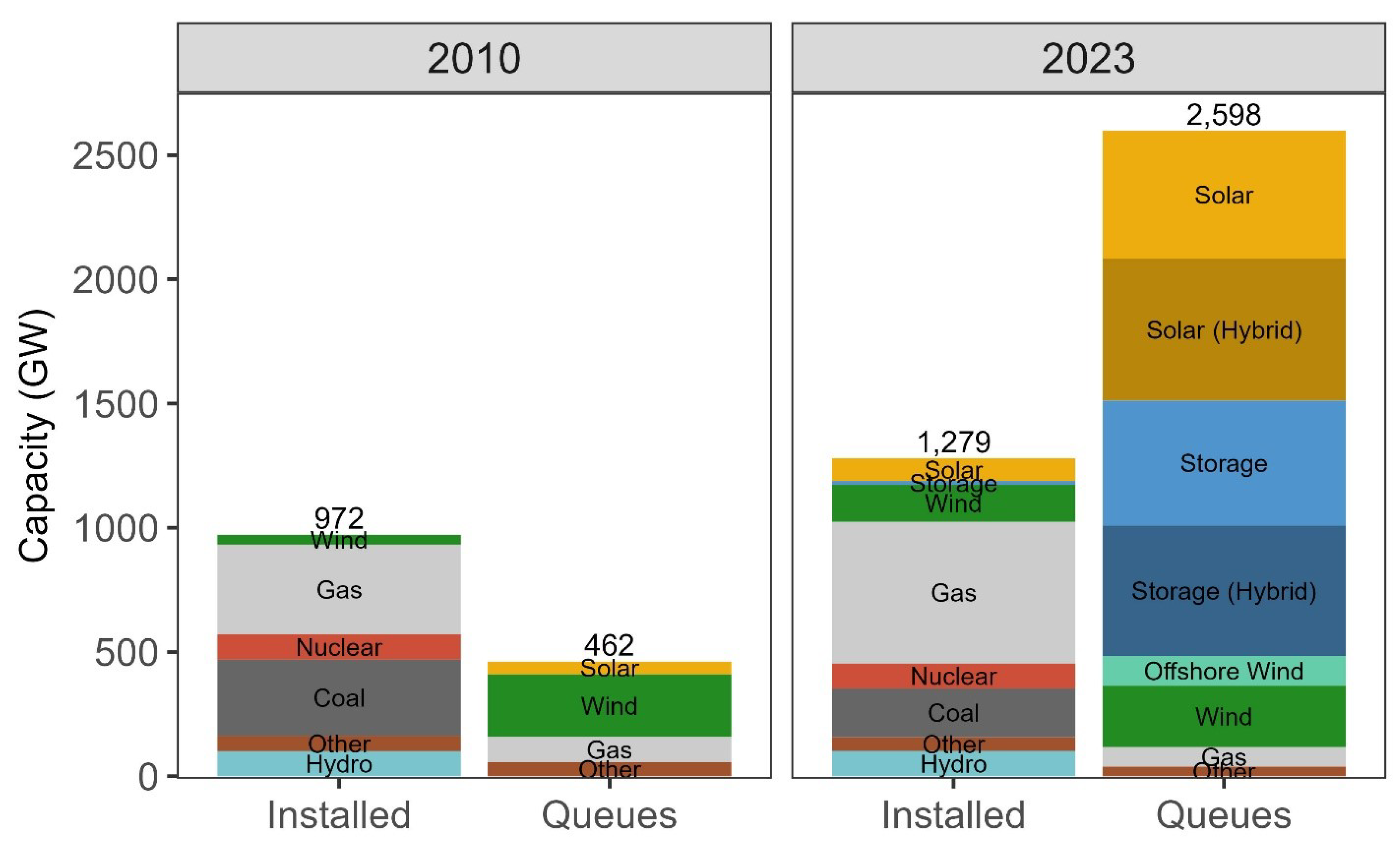

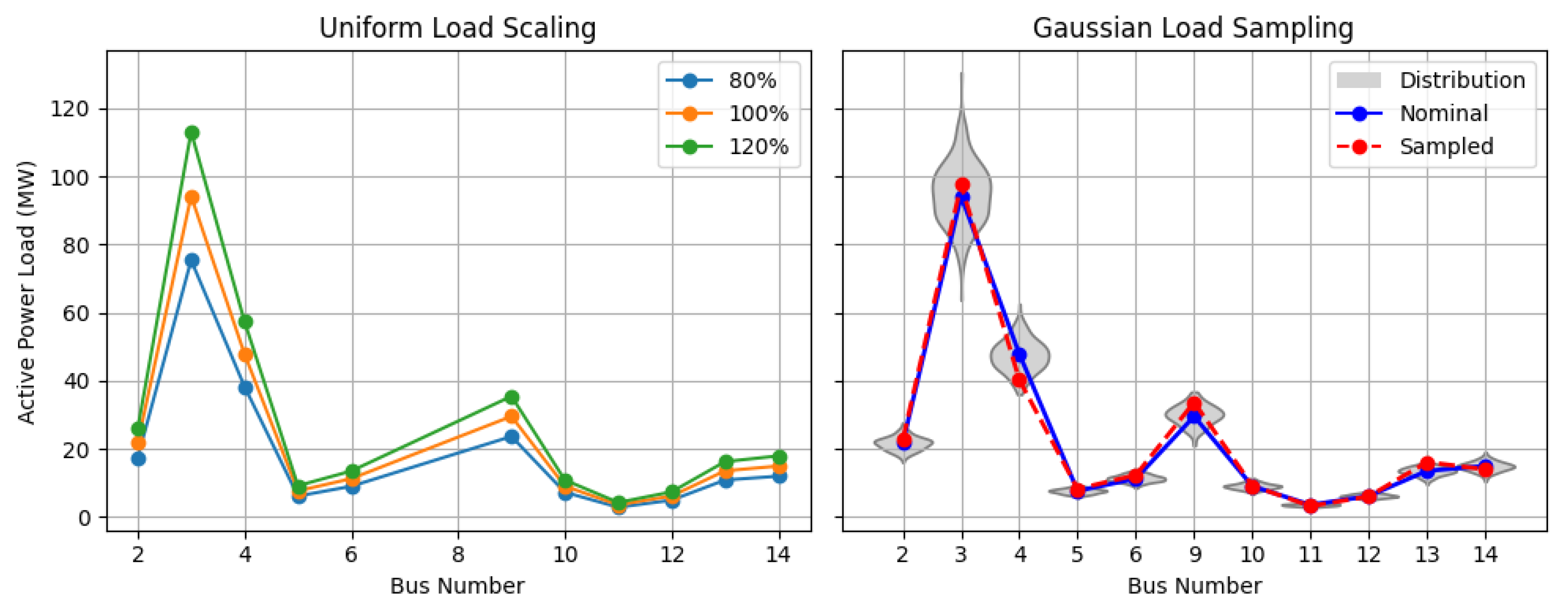


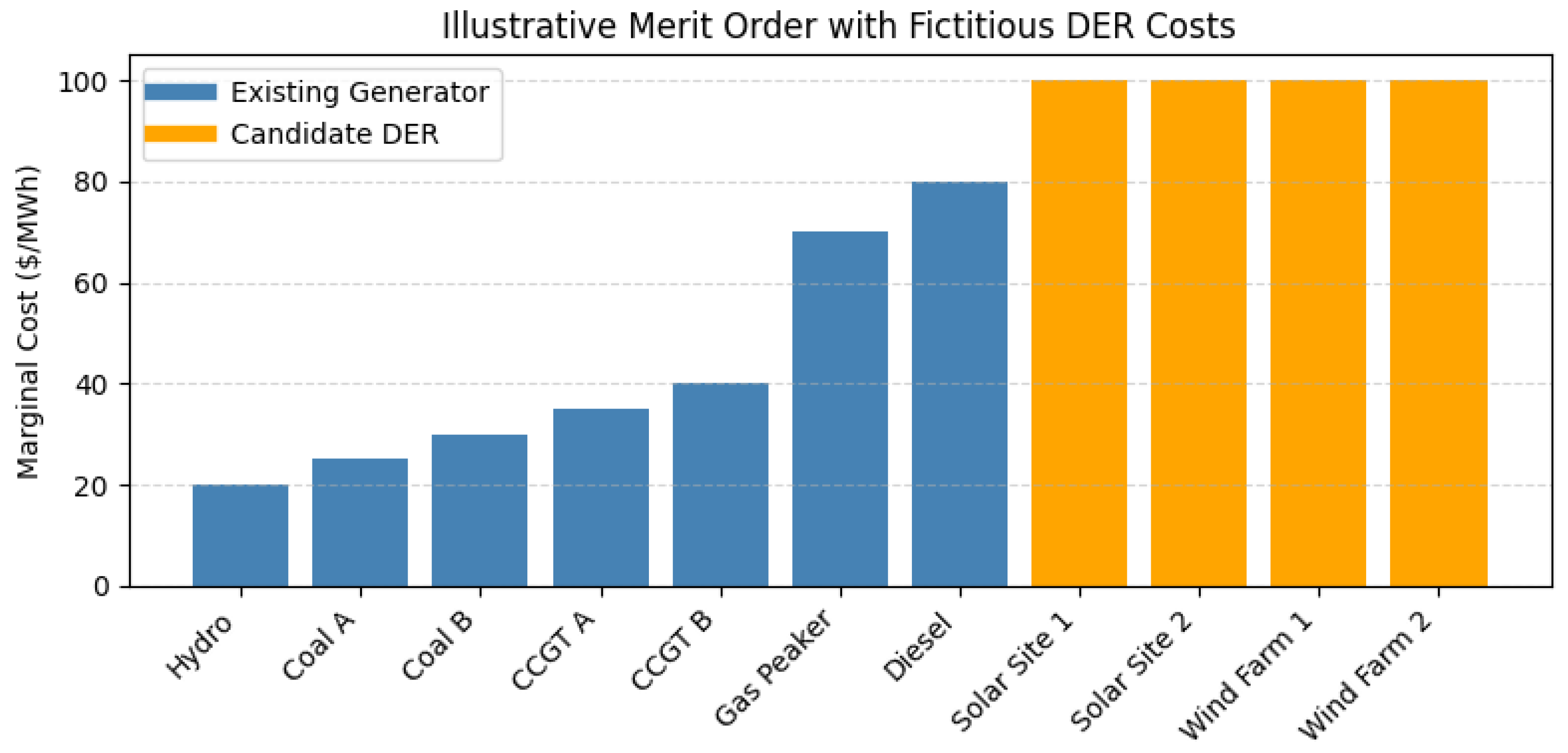


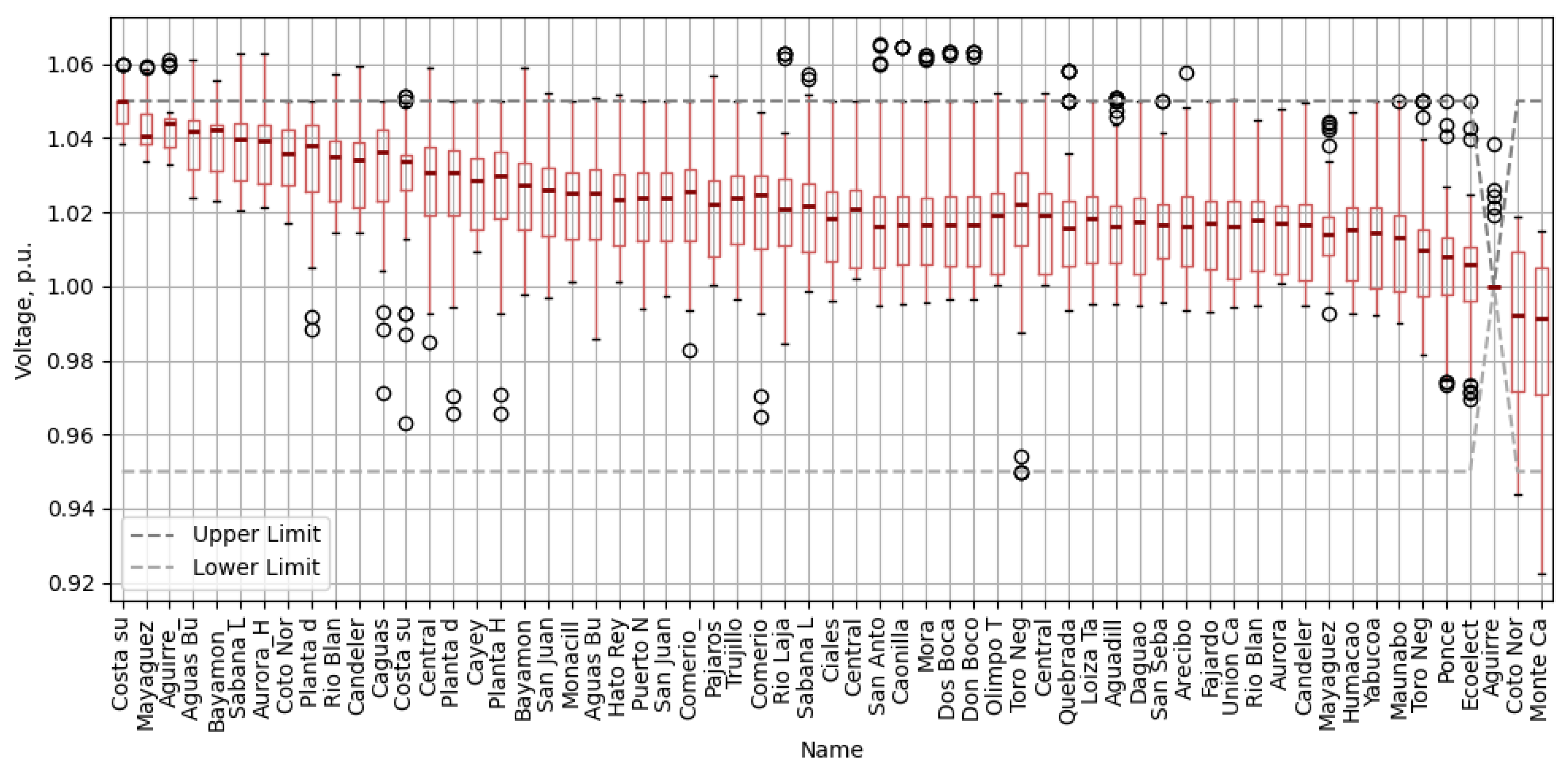


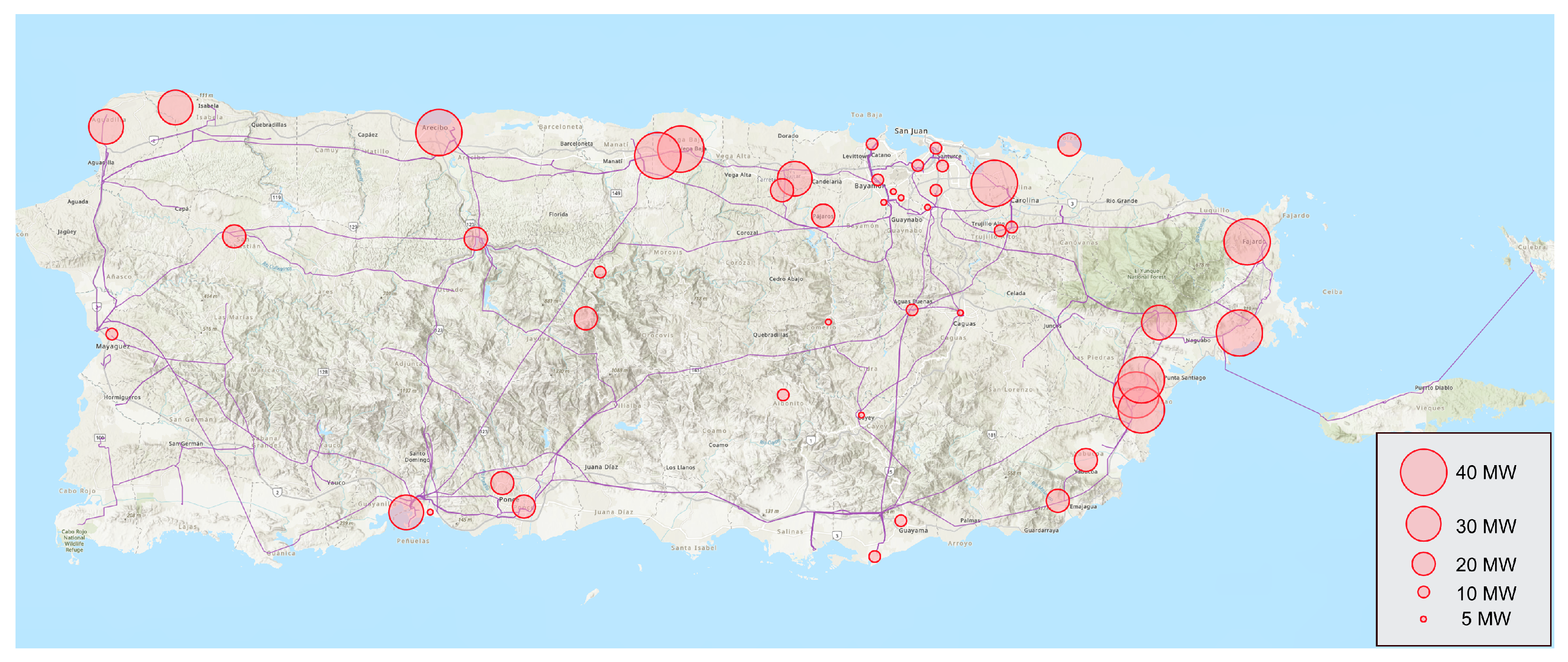

| Retirement Stage | Reliability | 95% CI Width | Num. of Scenarios (Feasible/Total) |
|---|---|---|---|
| R1 | 0.9444 | ±0.1058 | 17/18 |
| R2 | 0.9444 | ±0.1058 | 17/18 |
| R3 | 0.8889 | ±0.1452 | 16/18 |
| All | 0.9306 | ±0.0587 | 67/72 |
Disclaimer/Publisher’s Note: The statements, opinions and data contained in all publications are solely those of the individual author(s) and contributor(s) and not of MDPI and/or the editor(s). MDPI and/or the editor(s) disclaim responsibility for any injury to people or property resulting from any ideas, methods, instructions or products referred to in the content. |
© 2025 by the authors. Licensee MDPI, Basel, Switzerland. This article is an open access article distributed under the terms and conditions of the Creative Commons Attribution (CC BY) license (https://creativecommons.org/licenses/by/4.0/).
Share and Cite
Anton, L.L.; Ilić, M.D. Probabilistic Deliverability Assessment of Distributed Energy Resources via Scenario-Based AC Optimal Power Flow. Energies 2025, 18, 4832. https://doi.org/10.3390/en18184832
Anton LL, Ilić MD. Probabilistic Deliverability Assessment of Distributed Energy Resources via Scenario-Based AC Optimal Power Flow. Energies. 2025; 18(18):4832. https://doi.org/10.3390/en18184832
Chicago/Turabian StyleAnton, Laurenţiu L., and Marija D. Ilić. 2025. "Probabilistic Deliverability Assessment of Distributed Energy Resources via Scenario-Based AC Optimal Power Flow" Energies 18, no. 18: 4832. https://doi.org/10.3390/en18184832
APA StyleAnton, L. L., & Ilić, M. D. (2025). Probabilistic Deliverability Assessment of Distributed Energy Resources via Scenario-Based AC Optimal Power Flow. Energies, 18(18), 4832. https://doi.org/10.3390/en18184832






